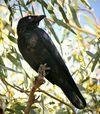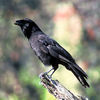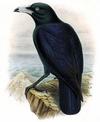Genus Corvus

White-necked Raven - It occurs in eastern and southern Africa in open, mountainous country. It is quite commonly found in small towns and villages as long as there are mountains or hills for roosting and nesting relatively near by.
Pied Crow - Structurally, the Pied Crow is better thought of as a small crow-sized Raven, especially as it can hybridise with the Somali Crow where their ranges meet in the Horn of Africa. Its behaviour, though, is more typical of the Eurasian Carrion Crows, and it may be a modern link between the Eurasian crows and the Common Raven.
Little Crow - It ranges over western and central Australia, often inhabiting very dry, near desert areas. It frequents small country towns and cultivated areas, where its flocks have reminded people of the European Rook.
American Crow - It is one of several species of corvid that are entirely black, though it can be distinguished from the other two such birds in its range—from the Common Raven by size and behavior and from the Fish Crow by call .
Black Crow - This species occurs in two large separate regions of the African continent. One form ranges from the Cape at the southern tip of Africa up to southern Angola and across to the east coast of Mozambique. The other population occurs in a large area from Sudan, Ethiopia,Tanzania and Kenya in central east Africa. The more northern population is on average slightly smaller than the southern. It inhabits open grassland, moorland, agricultural areas with some trees or woodland in the vicinity for nesting. It seems to thrive especially in agricultural areas.
Northwestern crow - This species was described by Spencer Fullerton Baird in 1858.
Northern raven - The Common Raven has coexisted with humans for thousands of years and in some areas has been so numerous that it is considered a pest. Part of its success comes from its omnivorous diet; Common Ravens are extremely versatile and opportunistic in finding sources of nutrition feeding on carrion, insects, cereal grains, berries, fruit, small animals, and food waste.
Hooded Crow - The Carrion Crow was one of the many species originally described by Linnaeus in his 18th century work Systema Naturae and it still bears its original name of Corvus corone.
Australian Raven - It is omnivorous and has adapted well to urban environments and is a common city bird in Sydney and Canberra.
Thick-billed Raven - This raven has very short feathers on the head, throat and neck, which on the throat and upper breast have an oily brown gloss. The rest of the bird is glossy black except for a distinctive white patch of short feathers on the nape and onto the neck.
White-necked Raven - The Chihuahuan Raven occurs in the Southwestern and Midwestern United States and northern Mexico, including southeastern Arizona, southern New Mexico, southeastern Colorado, western Kansas, western Oklahoma, and southern and western Texas.
Daurian Jackdaw - It is the same size or perhaps slightly smaller than the latter species, with the same proportions and identical habits. The principal difference is its plumage; many but not all adults of this species have large areas of creamy white on the lower parts extending up around the neck as a thick collar. The head, throat, wings and tail are glossy black and the ear coverts are grizzled grey. Darker adults and young birds resemble Eurasian Jackdaws, though Daurian Jackdaws have a black iris, unlike the distinctive grey-white iris of the Eurasian Jackdaw.
Slender-billed Crow - The Slender-billed Crow is a species of bird in the Corvidae family. Its eastern populations are called Violaceous Crow and sometimes separated as Corvus violaceus.
Flores Crow - Its natural habitats are subtropical or tropical dry forests and subtropical or tropical moist lowland forests. It is threatened by habitat loss.
Rook - This species is similar in size to or slightly smaller than the Carrion Crow with black feathers often showing a blue or bluish-purple sheen in bright sunlight. The feathers on the head, neck and shoulders are particularly dense and silky. The legs and feet are generally black and the bill grey-black.
Brown-headed Crow - Its natural habitats are subtropical or tropical moist lowland forests and subtropical or tropical mangrove forests. It is threatened by habitat loss.
Alala - The ʻalalā is now extinct in the wild. Prior to this, the species was found only in the western and southeastern parts of the island of Hawaiʻi.
Tamaulipas Crow - Occurring in a relatively small area in north-eastern Mexico, it inhabits near desert scrub and bushland and includes farms, small towns and villages in its range. It also occurs in more humid woodland in open areas but does not appear to be found in the higher mountains or along the seashore. It is a sociable bird often forming large flocks, moving together in close groups. Its northern range reaches Brownsville in southern Texas where it has been known to nest.
Jamaican Crow - As its name suggests, this species is found on the moderately sized island of Jamaica where it inhabits woodland mixed with cleared areas and can be frequently found in larger gardens also. Though primarily a bird of hill and mountain forest, it comes down to lower elevations during the dry season where it is more likely to be seen.
Mariana Crow - The Mariana Crow is a small black crow with a bluish-black gloss on its tail, and a greenish-black gloss on its back, underparts, head, and wings. In general, females are smaller than males. An adult weighs about 9 ounces and is about 15 inches long.
Porto Rican crow - A stocky bird, this forest crow is now found principally on the large island of Hispaniola that comprises the countries of Dominican Republic and Haiti. It was also found on Puerto Rico but is now considered to be extinct on that island since the early 20th Century due to considerable forest clearance and hunting. It inhabits both lowland and mountain forest and unlike the related Cuban Crow, does not appear to tolerate areas that have been cleared for farming. It often flies high over the forest canopy and soars on thermals unlike the conspesific Palm Crow which rarely if ever soars.
Jungle Crow - The Jungle Crow is a species of bird in the Corvidae family. It is found in Bangladesh, India, Myanmar, Nepal, Sri Lanka, and Thailand.
Large-billed Crow - There are three sub-species within this group that are sometimes treated as full species:
Bougainville Crow - The Bougainville Crow heavy crow, 41 cm long, with all black plumage and a massive black bill. Its natural habitats are subtropical or tropical moist lowland forests and subtropical or tropical moist montane forest up to 1600 m. At present it is a common species on Bougainville, but it might be threatened in the future by habitat loss caused by logging.
Little Raven - Although the Little Raven was first named by Mathews in 1912, it was only in 1967 that there was consensus to separate it from the Australian Raven as a distinct species.
Eurasian jackdaw - The Jackdaw was one of the many species originally described by Linnaeus in his 18th century work, Systema Naturae, and it still bears its original name of Corvus monedula.
New Caledonian Crow - The New Caledonian Crow is a moderately sized crow similar in size to the House Crow but less slender looking. The bird is all black with a rich gloss to the feathers of purple, dark blue and some green in good light. The beak, feet and legs are all black too. The beak is of moderate size but is unusual in that the tip of the lower is angled up making it somewhat chisel-like in profile.
Cuban Crow - A stocky, medium sized forest crow, this sociable bird can be found quite commonly over most of the large island of Cuba and on the nearby Isla de la Juventud in woodland and areas that have been cleared for agriculture. It is frequently found around farms and villages where it seems to have adapted quite well to living in relatively close contact with man.
Australian Crow - The Torresian Crow was described by ornithologist Charles Lucien Bonaparte in 1850,
Fish crow - The Fish Crow was first described by Alexander Wilson in 1812. The latest genetic testing now seems to indicate that this species is close to both the Sinaloan Crow, and the Tamaulipas Crow, and not as close to the American Crow, as outward signs would suggest.
Palm Crow - Both forms appear to be closely related to the Fish Crow of the East Coast of the United States and also two smaller species, the Tamaulipas Crow and Sinaloan Crow of Mexico and forms a species group with them.
Fan-tailed Raven - The Fan-tailed Raven is completely black including bill, legs and feet and the plumage has a purplish-blue gloss in good light. Worn plumage is slightly coppery-brown. The base of the feathers on the upper neck are white and only seen if the bird is inspected or a strong gust blows them the wrong way. The throat hackles are shorter than in most other ravens.
Brown-necked Raven - This species has a wide range across virtually the whole of North Africa, down as far as Kenya, the Arabian peninsula and up into the Greater Middle East and southern Iran. It lives in a predominantly desert environment visiting oases and palm groves.
Sinaloa Crow - It occurs on the Pacific slope from southern Sonora south to central Nayarit. The crow inhabits coastal regions where it forages on the seashore, semi-desert, open woodlands, river banks and hills up to 300 metres or more. It is very common around coastal towns and villages.
Indian House Crow - In the dry parts of South Asia and Iran the subspecies C. s. zugmayeri is found and this has a very pale neck collar. The nominate race is found in India, Nepal and Bangladesh and has a grey neck collar. In southern India, the Maldives and Sri Lanka, the subspecies C. s. protegatus is darker grey. The darkest form however is the Myanmar form C. s. insolens and lacks the grey collar.
Forest Raven - The Forest Raven is 50–52 cm in length with glossy black plumage and a white iris. It has a proportionately larger bill and shorter tail than the other mainland corvid species and is the sole representative of the genus Corvus in Tasmania. The call is a deep "korr-korr-korr-korr" with a similarly drawn out last note to the Australian Raven.
Collared Crow - It is about the same size or slightly larger than the Carrion Crow , with proportionately slightly longer wings, tail and bill. A sleek and handsome bird, it has glossy black plumage except for the back of the neck, upper back , and a broad band around the lower breast that is white. The bill, legs and feet are black.
Gray Crow - The tail feathers are relatively long and graduated and the legs are relatively short. The overall colouring of the adult bird is black with randomly bleached wing and tail feathers. A large region around the eye is quite bare of feathering and shows pinkish-white skin with the eyes a bluish-white. The bill is unusual too in being very variable, bluish on upper mandible and pinkish-white on the lower in some specimens, while on others the whole bill is pinkish white with a darker tip. The forward pointing nasal bristles so often prominent in other Corvus species are very reduced also.
Piping Crow - Its natural habitat is subtropical or tropical moist lowland forests.
Banggai Crow - The Banggai Crow, Corvus unicolor, is a member of the crow family from Banggai in Indonesia. It is listed as critically endangered by IUCN and was even feared extinct, but was finally rediscovered during surveys on Peleng Island by Indonesian ornithologist Mochamad Indrawan in 2007 and 2008.
White-billed Crow - It is a short and stocky forest bird with a short squared off tail and a relatively large head with a very distinctive deep and curved pale ivory coloured bill with a darker tip. The dark nasal bristles though not thick are quite apparent against the pale coloured bill. The bird overall is very glossy black with a greenish-purple gloss to the head and purple gloss to the rest of the body. The iris is pale grey or white in the adult bird and the legs and feet are black.























